
03
Dec
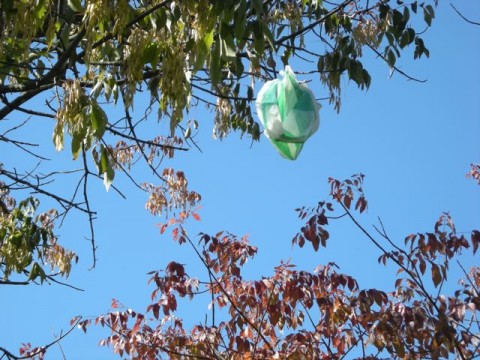
Culps Hill, Gettysburg, PA. Neither did the bag witness the battle, nor the combatants know plastic.
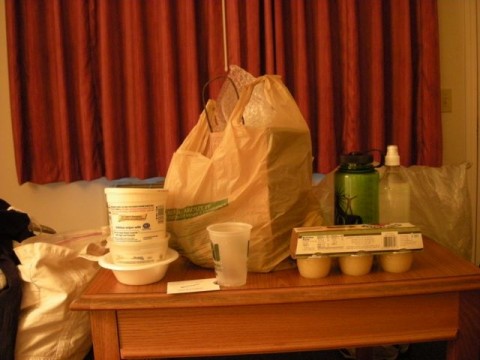
Motel, Baker City, OR. The accumulation of plastic from 6 days on the road, DC to Seattle 10/08
It’s the numbers, expanding large and small: giga- to tera-, nano- to peta- scale. Physicist Hans Bethe explained that shopping between the world wars in Germany taught him the value of big numbers. He would bicycle to the shops for the items his family needed. Gradually, steadily it took the capacity of his handlebar-mounted basket to carry the stack of inflating Deutsches Marks to pay the merchants. Orders of magnitude, times ten.
According to the website http://www.reusablebags.com, “Well over a billion single-use plastic bags are given out for free each day.” They form an incoming stream to my household in the form of grocery and farm market goods, dry cleaning and laundry bags, shipping bags for clothing and medications, book and miscellaneous purchase-carriers from garment bag-size, to bubble wrap-liners and Styrofoam chips or peanuts. Then, too, the difficult-to-substitute containers for yoghurt, and drinks, the quart and half-gallon boxes and jugs all labeled #5 or #6, are not currently recyclable, and so expand the trash.
Down the chute, but not out of mind. Truthfully, it is my mind, my serenity that feels threatened.
With the inevitable rise in petroleum prices due to production reaching the long-heralded and long-denied peak oil, and for living in a fifth-floor small apartment in the Capitol City, I have begun to question how to reduce this tide of incoming one-use plastic? How to educate myself and others to analyze the true, lifetime costs of production, product, and disposal. Plastics are eternal.
In The Upside of Down(2006), Canadian scholar Thomas Homer-Dixon helpfully defines the energy return on investment, EROI. The rise and decline of a civilization or nation state correlates with the ease of marshalling energy. For the Roman coliseum and the aqueducts, engineers mobilized a well-fed labor force to build ingeniously designed and precisely crafted arches, stones, tiles and bricks. The agrarian economy produced the high quality calories, food for laborers and animals to build and maintain such works. However, “locked into a food-based energy system, as the Roman empire, expanded and matured; as it exploited, and in some cases exhausted, the Mediterranean region’s best cropland and then moved on to cultivate poorer lands; and as its grain supplies snaked farther and farther from its major cities, it had to work harder and harder to produce each additional ton of grain.” (P. 55)
In our time, petroleum yields three great essential energies: chemicals including fertilizers, plastics, and fuel. Farmers choose to use manure-based fertilizers with some dangers of pathogens persisting, and still requiring fuel to heat, transport and distribute, or chemical fertilizers. Farmer Eddy Rankin of Twin Springs Fruit Farm, Orrtanna, PA, reports that last year he paid less than $360 per ton of 19-19-19 (NPK) fertilizer. Now it tops $1000, a three-fold increase. To protect soil fertility and crop yields, he and his partners continue to apply the preferred fertilizer, and only modestly raise prices at the stand. Does this price increase herald a change for energy return on investment, EROI?
At the time of sale, producers of the corn crop face three choices: feed people, feed livestock, or feed fuel tanks. Purchasers compete. Heifer International reported in 2008 that the proportion of annual greenhouse gases in the United States is 18% from producing livestock for meat compared to 13% for all forms of transportation. These choices explain why food costs have risen, will continue to rise, and illumine the widening gap between rich and poor, well nourished and starving. Again, the numbers are staggering and hard to comprehend. Furthermore, the income gap between billionaires and poor people is so great that compounding increases will fail to reduce the gulf for generations to come (Homer-Dixon, 2006).
At the Republican Convention the cheer, “drill, baby, drill” roiled the crowd, hot to open the last great North American wilderness in Alaska to resource exploitation. Too many Americans do not yet grasp the idea of energy return on investment. Furthermore, Elizabeth Kolbert quotes “The Department of Energy estimates that there are eighteen billion barrels of technically recoverable oil in offshore areas of the continental United States that are now closed to drilling. This sounds ample, until you consider that oil is traded globally and that, at current rates of consumption, eighteen billion barrels would satisfy less than seven months of global demand. A DOE report issued last year predicted that it would take two decades for drilling in restricted areas to have a noticeable effect on domestic production, and that, even then, ‘because oil prices are determined on the international market,’ the impact on fuel costs would be ‘insignificant’.” (The New Yorker, Aug. 11 & 18, 2008).
Who will ask, “Is it worth it?” What about species loss as the Arctic Ocean shrinks and habitats change? What about rising sea levels? Since Hurricanes Katrina and Rita, we are slightly more sensitive to the power of nature, and newly appreciative of wetlands. Still, half the United States’ supply of oil passes through the ports of Louisiana (NPR, All Things Considered, 5 September 2008). Can we afford to abandon the drilling platforms, refineries, and transfer points of the Gulf of Mexico to exploit and maybe exhaust the Alaskan coasts?
Living in Washington DC, I have searched for food sources like Puget Consumers Cooperative in Seattle for local, organic foods. I carry a handy nylon bag and extra clean plastic “T-shirt” bags while shopping. I wash, dry, and reuse every possible plastic bag. Following the example of my daughter and my website designer, I carry a sealable plastic 12-ounce thermal cup, especially on airplanes. We avoid restaurants serving on Styrofoam and plastic. Remembering the one billion plastic bags handed out free worldwide per day, I talk with merchants as I unfold my recycled bags.
Nonetheless, the waste stream appalls. Because the air pollution controls are looser than in the United States, some “recycled” items go to Asian countries where they are burned. We eat meat as a condiment and pay attention to the source and species of our seafood. We combine trips and limit our use of the car. People can sign up for Terrapass and purchase carbon credits for travel expenditures.
“Little drops of water, tiny grains of sand, make the mighty ocean and the spacious land”goes the song learned in first grade… the numbers… the math. Plastics are eternal. We Homo sapiens are mobile bags of water with about 15% other chemicals, that somehow embody a mind, a spirit. Can we govern ourselves, reign in our desires, understand and meet these sweeping changes? Can we imagine life as other living beings live, whales and elephants, tuna and turtles, bacteria and in-between viruses? And live as though the future matters? I hope so, I pray so, I write so.
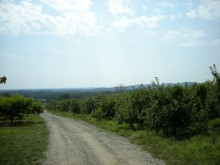

L. View of Little Round Top, Gettysburg, from Twin Springs Fruit Farm, Orrtanna, PA
R. Greenhouse, opposite direction
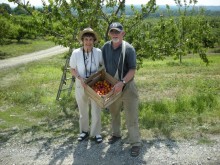
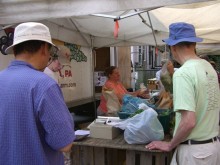
L. Julie and Eddy Rankin with fresh-picked apricots, July 4, 2008
R. Shogo Hayashi and Seelye buying from Martha at the TSFF Saturday Market
All Souls Memorial Episcopal Church, Washington DC